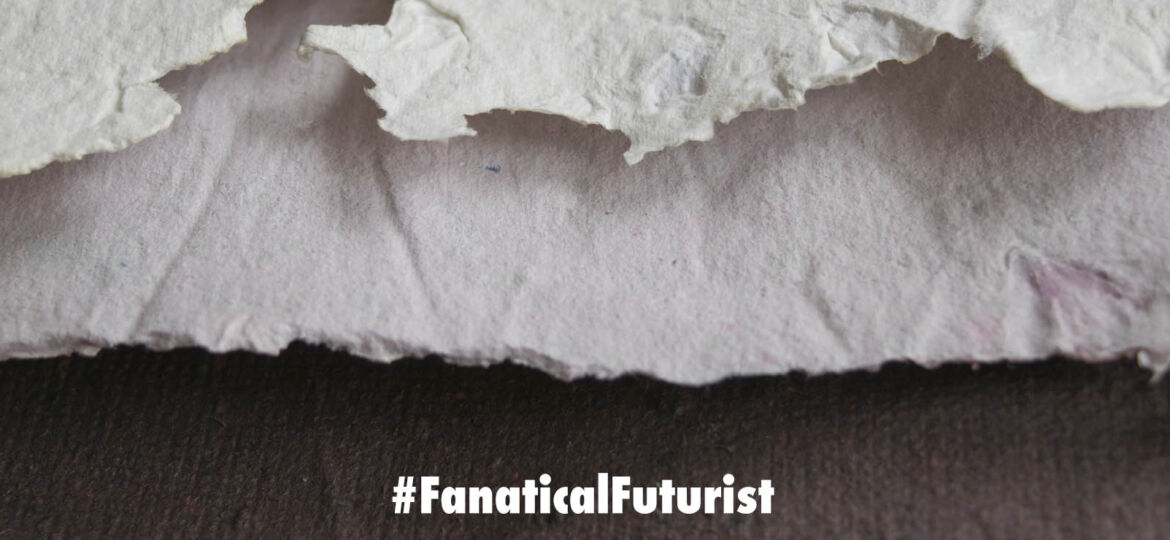
WHY THIS MATTERS IN BRIEF
Increasingly everything can be turned into an electronic smart device – even paper – and innovations like this will make a raft of new products possible.
 Love the Exponential Future? Join our XPotential Community, enjoy exclusive content, future proof yourself with XPotential University, connect, watch a keynote, or browse my blog.
Love the Exponential Future? Join our XPotential Community, enjoy exclusive content, future proof yourself with XPotential University, connect, watch a keynote, or browse my blog.
I’ve heard of plenty of odd electrical innovations over the years – from the development of flexible electronics circuits that re-configure themselves and the development of self-healing circuits, edible electronics and liquid electronics, and electronics used by the military that vaporise themselves on command to avoid being captured, and much more …
Now though, after scientists found a way to make paper from stone, scientists in the US have unveiled a new printing process that turns ordinary paper or cardboard into a rugged, flexible electronic circuit and their latest demo was a waterproof keyboard that you can fold up and put in your pocket – and it doesn’t require a power source to work.
Turn your sheet of A4 into a computer keyboard …
The tech makes use of a special coating that’s repellent to liquids and dust, which allows multiple circuit layers to then be printed on top of the paper without any smudging or degradation between the layers.
… or an actual keyboard!
On the other side of the paper or cardboard, standard ink printing can then be used to point out where the pressure points, the buttons, are and what they represent. As you can see from the video these layers can be printed in any design you want, from numerical keypads to volume controls.
Furthermore, no batteries or power plugs are required to operate the finished devices because they use something called a Triboelectric Nanogenerator or TENG device, that I’ve talked about before when researchers elsewhere used the tech to give human skin spiderman like superpowers, that’s capable of powering the devices from the users touch and the mechanical energy it produces.
“This is the first time a self-powered paper-based electronic device has been demonstrated,” says biomedical engineer Ramses Martinez, from Purdue University.
“We developed a method to render paper repellent to water, oil and dust by coating it with highly fluorinated molecules. This omni-phobic coating allows us to print multiple layers of circuits onto paper without getting the ink to smear from one layer to the next one.”
When the printed parts of the paper get pressed, they’re able to transmit signals over Bluetooth to another device – a laptop, for example. You’ve then got a lightweight, foldable keyboard that can be taken anywhere and easily wiped clean when needed.
The technology ticks plenty of boxes – it scales up well using existing production processes, it’s good for the environment, because the paper can be simply recycled again, and it’s flexible – as well as being water-resistant and completely customisable.
The paper devices are also cheap to produce as well – less than $0.25 each, according to the researchers which even when you compare that price to the cheapest keyboards on the market, for example, is orders of magnitude less. However, asides from keyboards the technology can also be used for smart packaging, or where temporary input devices are required. You can see paper being used a volume control in the video above.
“I envision this technology to facilitate the user interaction with food packaging, to verify if the food is safe to be consumed, or enabling users to sign the package that arrives at home by dragging their finger over the box to properly identify themselves as the owner of the package,” says Martinez.
“Additionally, our group demonstrated that simple paper sheets from a notebook can be transformed into music player interfaces for users to choose songs, play them and change their volume.”
The research has been published in Nano Energy, and if the above applications are anything to go by then, even though this technology might sound tame, it could have a big impact across a wide number of areas.
















